
Catalog excerpts
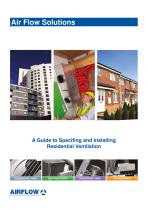
A Guide to Specifing and Installing Residential Ventilation
Open the catalog to page 1
Create a healthier indoor environment with fast, effective ventilation From a quiet, low energy fan to a whole house solution ® Sophisticated, stylish extraction Super quiet, energy efficient Ventilation with Heat Recovery Providing warmed, fresh, filtered air throughout the house...and saving energy too!
Open the catalog to page 2
Contents Section 1: Why we need to ventilate Airtight Homes Condensation Carbon Emissions Mould Toxic Gases Noise Concept of Extract Ventilation Section 2: Selecting the correct product What options are available? Intermittent Extract Fans (System 1) Continuous Mechanical Ventilation (MEV/dMEV) (System 3) Mechanical Ventilation with Heat Recovery (MVHR) (System 4) Hygienic, Zero Leakage Ducting Installed Performance Domestic Ventilation Compliance Guide What Type of Fan Where to Install Section 3: Good Practice Delivers Performance Fan Installation Duct Installation Section 4: Building...
Open the catalog to page 3
Why we need to ventilate Airtight Homes Modern dwellings are designed with increasingly reduced air infiltration rates, higher levels of insulation making them almost completely sealed. Consequently the air inside may become moist, stale and generally stuffy and unpleasant to breathe. As we spend nearly 70% of our time at home we should be looking after our indoor air quality and environment. Condensation Dampness is a huge problem in the U.K. Damaging to both humans and to the fabric of buildings, condensation forms when the temperature of a surface (walls, mirror etc) is below the dew...
Open the catalog to page 4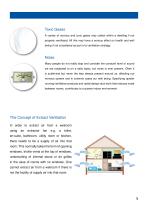
Toxic Gases A variety of noxious and toxic gases may collect within a dwelling if not properly ventilated. All this may have a serious effect on health and well being if not considered as part of a ventilation strategy. Noise Many people do not really stop and consider the constant level of sound we are subjected to on a daily basis, but noise is ever present. Often it 20 is subliminal but never the less always present around us, affecting our nervous system and in extreme cases our well being. Specifying quieter running ventilation products and radial design duct work that reduces noise...
Open the catalog to page 5
Selecting the correct product What options are available? The Building Regulations recommend four principle methods of residential ventilation. Airflow have been specialising in the most effective methods for many years. The following is an overview of the best options available. An essential part of reducing carbon emissions is the need to develop and install more efficient appliances for more energy efficient dwellings to meet the relevant SAP ratings and provide lower specific fan power (SFP) ventilation products with longer life cycles. Intermittent Extract Fans (System 1) Wall or...
Open the catalog to page 6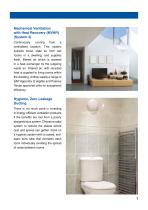
Mechanical Ventilation with Heat Recovery (MVHR) (System 4) Continuously centralised location. This system extracts moist, stale air from wet rooms in a dwelling, and supplies fresh, filtered air which is warmed in a heat exchanger by the outgoing waste air. Filtered air, with recycled heat is supplied to living rooms within the dwelling. Airflow supply a range of SAP Appendix Q eligible and Passive House approved units for exceptional efficiency. Hygienic, Zero Leakage Ducting There is not much point in investing in energy efficient ventilation products if the benefits are lost from a...
Open the catalog to page 7
Selecting the correct product Installed performance It is not sufficient to fit just any fan. It is important that the fan performs efficiently by extracting the minimum flow rate as required by the latest Building Regulations. The number of bends and the length of duct attached to the fan will create resistance to flow that must be overcome to ensure adequate extraction. This is known as installed performance. Fans should be positioned to give an optimum flow of air through the whole room and to avoid pockets of residual air. The location of planned or existing door and window openings...
Open the catalog to page 8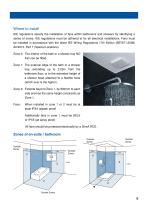
Where to install IEE regulations specify the installation of fans within bathrooms and showers by identifying a series of zones. IEE regulations must be adhered to for all electrical installations. Fans must be installed in accordance with the latest IEE Wiring Regulations 17th Edition (BS7671:2008) A2:2013. Part 7 (Special Locations). T Zone 0: he Interior of the bath or a shower tray NO Fan can be fitted. Zone 1: he external edge of the bath or a shower T tray, extending up to 2.25m from the bathroom floor, or to the extended height of a shower head attached to a flexible hose (which ever...
Open the catalog to page 9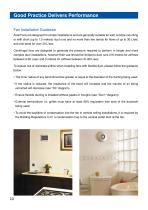
Good Practice Delivers Performance Fan Installation Guidance Axial Fans are designed for simple installations and are generally suitable for wall, window mounting or with short (up to 1.5 metres) duct runs and no more than two bends for flows of up to 30 L/sec and one bend for over 30 L/sec. Centrifugal fans are designed to generate the pressure required to perform in longer and more complex duct installations, however their use should be limited to duct runs of 6 metres for airflows between 0-30 L/sec and 3 metres for airflows between 31-60 L/sec. To reduce risk of restricted airflow when...
Open the catalog to page 10
Duct Installations Do Maximum length of flexible ducting Flexible ducting supports Minimum radius = the diameter of flexible ducting used Don't Bends and kinks (resistance) Preferred flexible ducting path Crushed ducting (resistance)
Open the catalog to page 11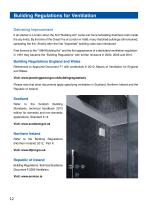
Building Regulations for Ventilation Delivering Improvement It all started in London when the first “Building Act” came into force forbidding thatched roofs inside the city limits. By the time of the Great Fire of London in 1666, many thatched buildings still remained, spreading the fire. Shortly after the first “inspected” building code was introduced. Fast forward to the “1984 Building Act” and the first appearance of a dedicated ventilation regulation. In 1991 they became the “Building Regulations” with further revisions in 2000, 2006 and 2010. Building Regulations England and Wales...
Open the catalog to page 12All Airflow Developments catalogs and technical brochures
-
Instruments
4 Pages
-
Whole House Ventilation
5 Pages
-
iCONstant
4 Pages
-
Residential Heat Recovery
30 Pages
-
Hand Dryers
5 Pages
-
Industrial Fans
15 Pages
-
Commercial Heat Recovery
19 Pages
-
Residential Fans
32 Pages
-
LOOVENT eco
8 Pages
-
Ventilation solutions
8 Pages
-
Aura-eco 150HT
2 Pages
-
Aura-eco 100T
2 Pages
-
QuietAir 100mm Axial Fan
8 Pages
-
fans blowers
2 Pages
-
fans
2 Pages
-
flue diltution
6 Pages
-
flue dilution
6 Pages
-
Loovent CV
2 Pages
-
Aura-eco 150B
2 Pages
-
100B and 150B Basic Aura ECO
1 Pages
-
Aura In-line 100T
2 Pages
-
Aura B
2 Pages
-
iCON 60
2 Pages
-
iCON 15 Shower Kit
2 Pages
-
iCON 15
2 Pages
-
AVENTA TURBO
9 Pages
-
QuietAir QT100B
2 Pages
-
Airovent HVS 10
6 Pages
Archived catalogs
-
Residential Heat Recovery
16 Pages




























